by Jason Bodner
December 5, 2023
The good news about forest fires is that they bring forth all sorts of new life sprouting from the ashes of the forest floor. As natural as forest fires may seem, the Insurance Information Institute tells us that human beings cause about 85% of all forest fires in the United States.
That’s a big number, but I’d say that about 100% of all stock market “fires” are caused by humans. And just like a forest, new life springs out of the market’s ashes. Well, August through October was another market “fire,” and we just closed another November that sprouted new market life. November of 2023 marked the third strongest November since 1980. The only better Novembers were in 2020 (+10.75%), and 1980 (+10.24%). The SPY (S&P 500 Tracking ETF) rose 9.13%, for a barn-burning performance.
As we can see below, the Big Money Index (BMI) struck again. For those who don’t know what that means, when the BMI goes oversold, big bounces are almost always right around the corner. The BMI is a MAPsignals proprietary indicator of outsized money flows; it helps identify when markets are either overbought or oversold. We alerted you to oversold conditions in October and warned that a big lift was coming, so carve another notch in BMI’s belt, because it nailed the next big market move yet again.
In this chart, we see the BMI rise from below 20% to roughly 60%:
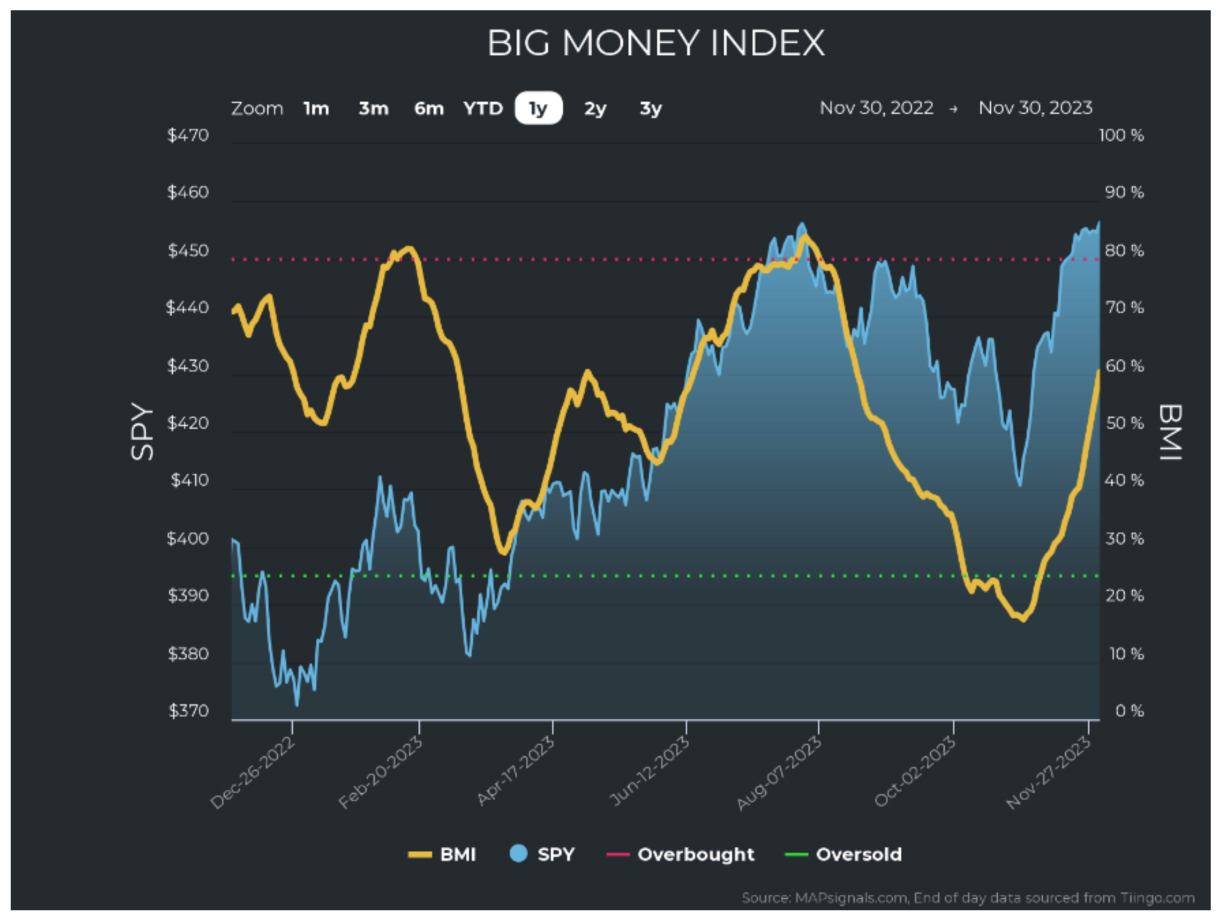
Graphs are for illustrative and discussion purposes only. Please read important disclosures at the end of this commentary.
Don’t be surprised if the BMI goes overbought sometime in December or January. That could easily happen, because unusually large selling has just vanished, giving way to serious buying.
We can see that here in the charts of Big Money Stock Buys and Sells, and ETF Buys and Sells:
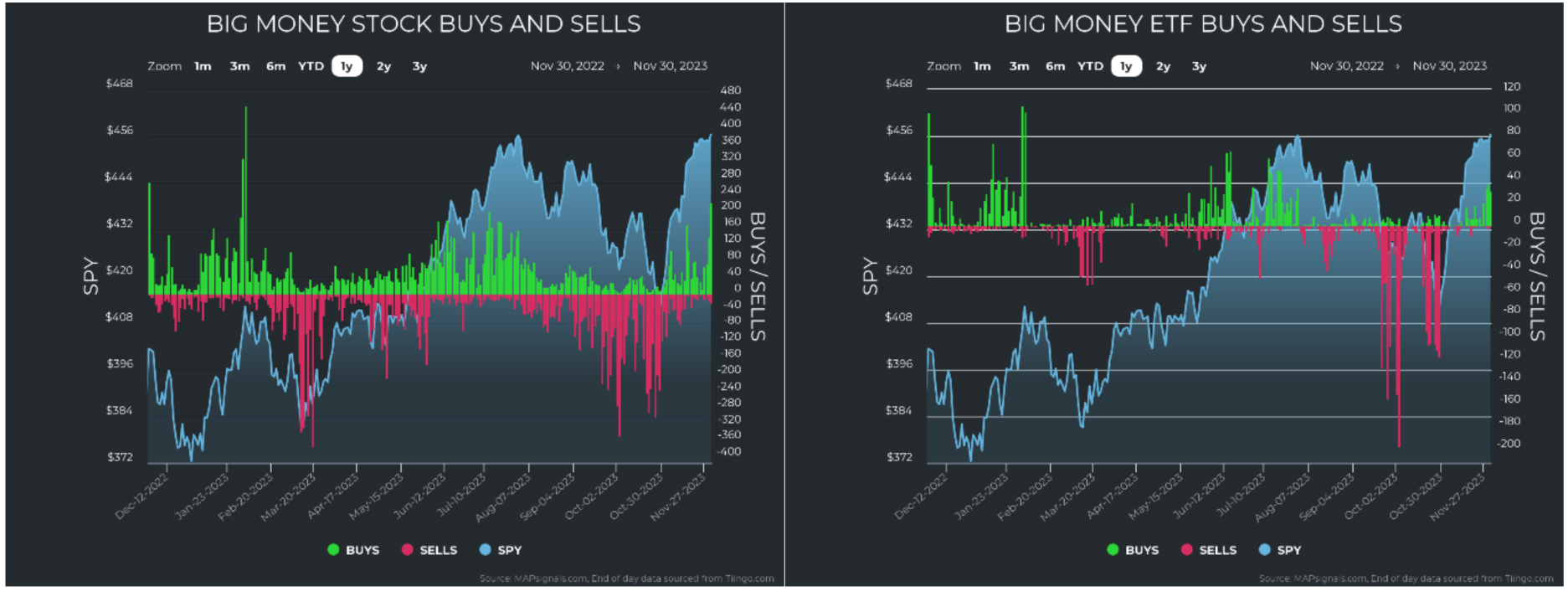
Graphs are for illustrative and discussion purposes only. Please read important disclosures at the end of this commentary.
Notice how the red (selling) just stopped when October clicked over into November? I am still convinced (although I have no data to back it up) that October saw a selling peak due to forced de-risking. In other words, I believe there were fund blowups forced by overwhelming redemptions from investors, forcing liquidations. That selling was characterized by huge volume. But the huge November bounce was also marked by big volume, as seen here, represented by the amber bars. Normally, volumes are multiples larger when selling comes – because everyone sells. Buying usually brings lower sustained volumes and smoother growth, but money rushed back in during November (minus light volume over Thanksgiving).
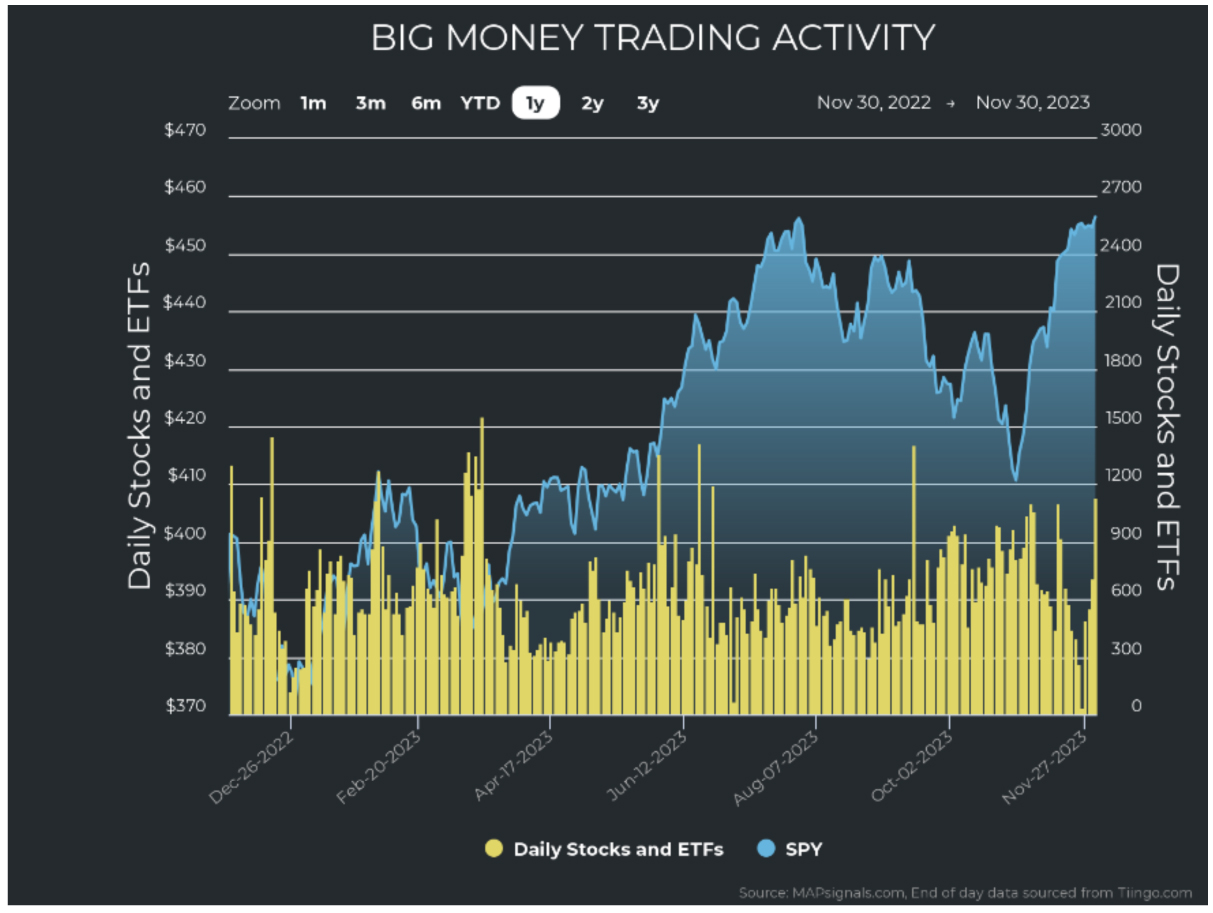
Graphs are for illustrative and discussion purposes only. Please read important disclosures at the end of this commentary.
I suspect this trend could continue, and even intensify. One main reason is that there is a contango (a situation where the futures price is higher than the spot price at maturity) going on between rates, inflation, and also economic data versus the news. Let me explain. First, let’s look at the CPI versus the fed funds rate. On November 14th, the Bureau of Labor and Statistics released their Consumer Price Index (CPI) for October, showing it unchanged at 3.2%. To spare you the details, energy prices fell, while food and shelter costs, while pesky, increased more slowly. With inflation unchanged, and the Fed funds effective rate at 5.33%, we are seeing a full 2.13% inverted spread between inflation and interest rates:
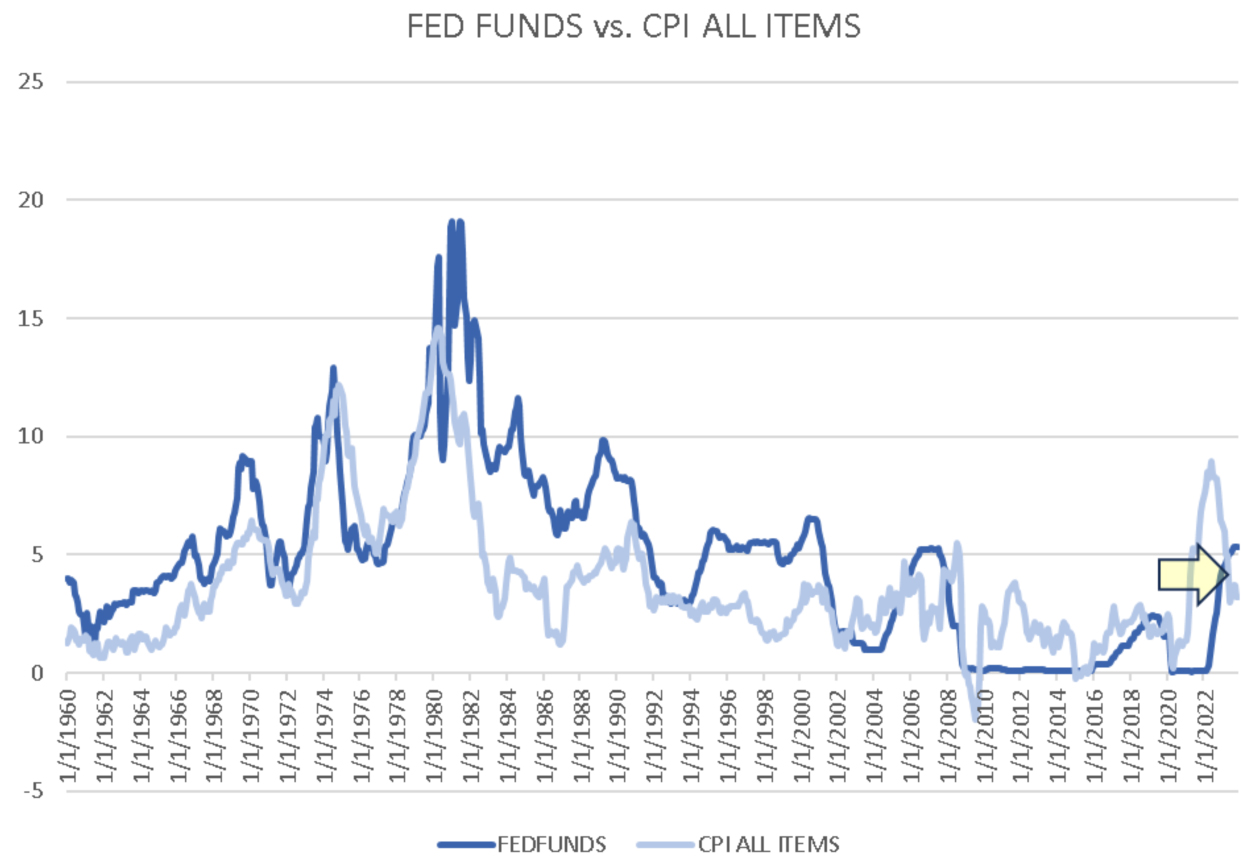
Graphs are for illustrative and discussion purposes only. Please read important disclosures at the end of this commentary.
Historically, this cannot last long, as you can see in the chart above. Add this to the fact that market rates are falling like a rock. The 10-year note has fallen from a high of near 5% in October to roughly 4.35%:
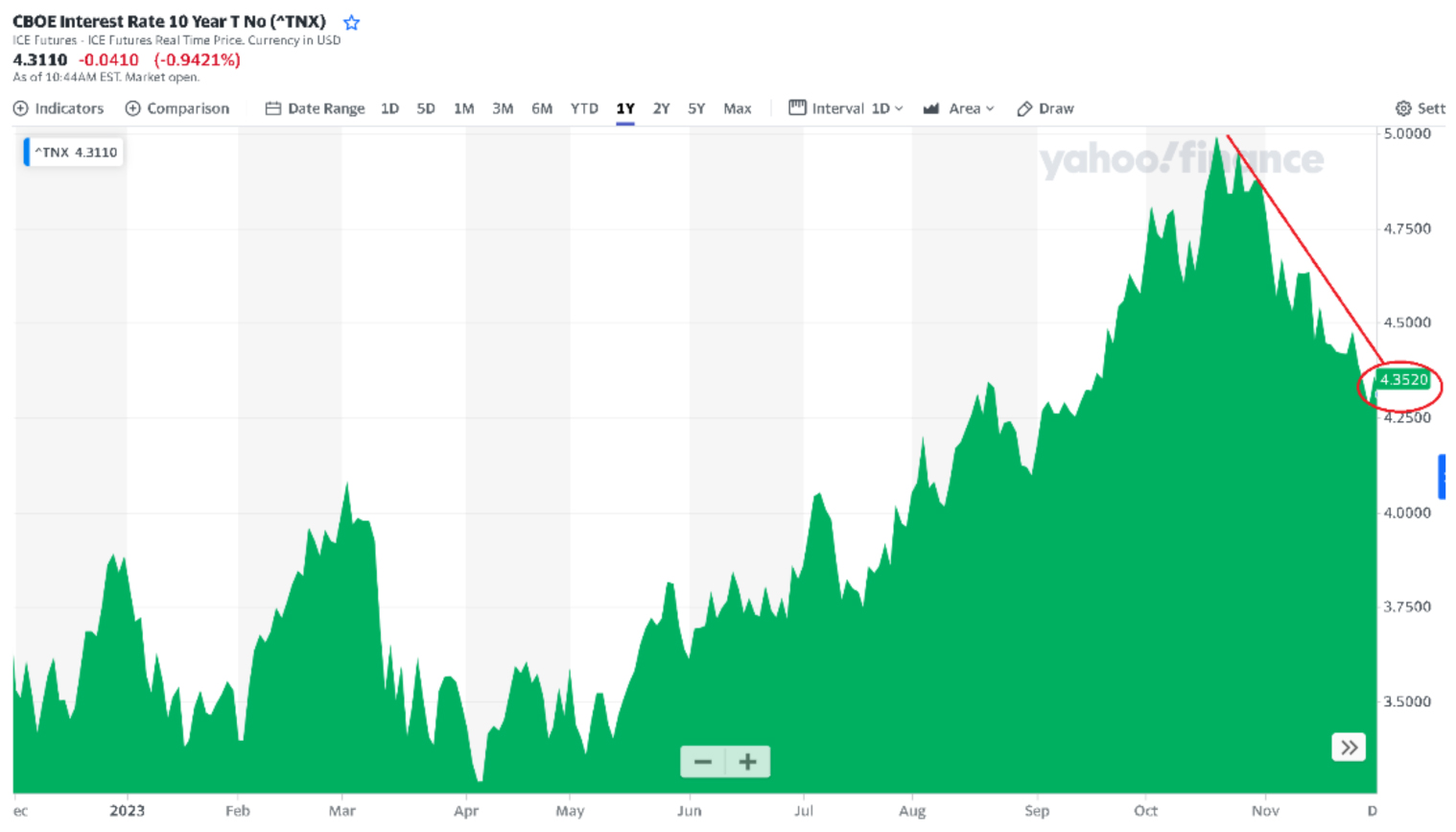
Graphs are for illustrative and discussion purposes only. Please read important disclosures at the end of this commentary.
Falling rates are good for some, bad for others. Those chasing high yields, in places like money markets, may suffer. Right now, there is the highest amount of cash in money markets on record, nearly $6 trillion:
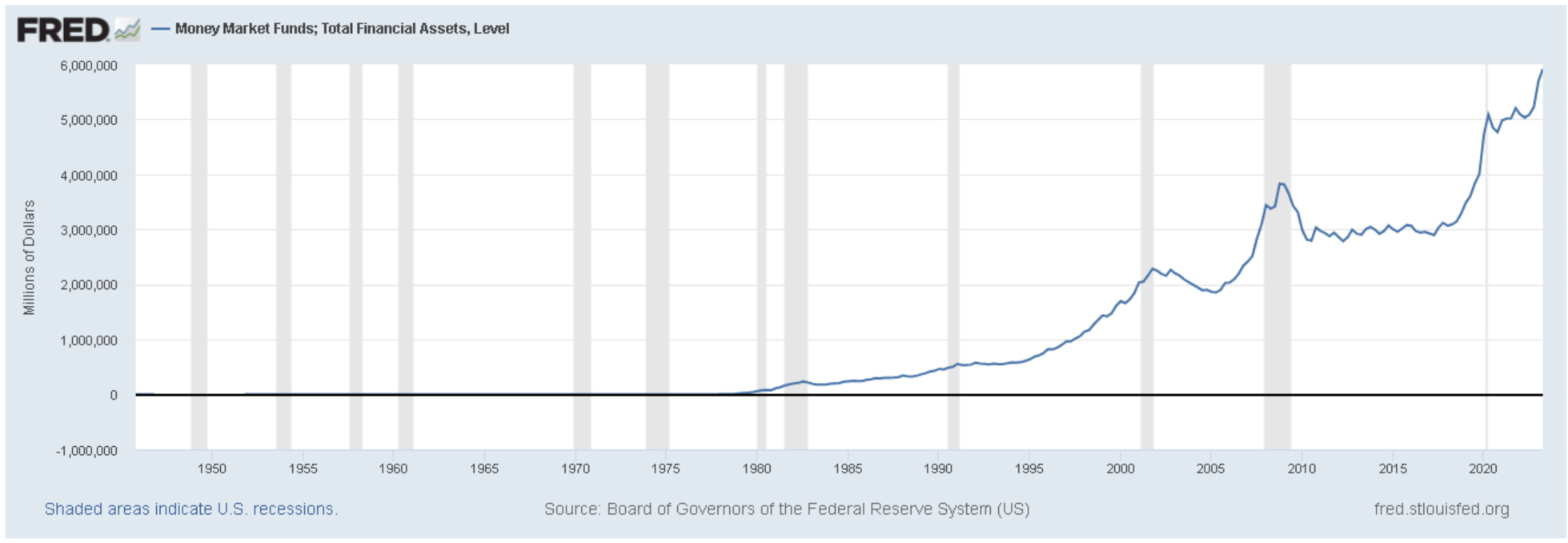
Graphs are for illustrative and discussion purposes only. Please read important disclosures at the end of this commentary.
The Fed doesn’t like to fight market rates, and market rates are falling. That’s a recipe for key short-term interest rate cuts in the future. And while places like Goldman Sachs expect cuts much later – in Q4 2024 – and Morgan Stanley expects cuts in Q3 2024, I suspect rate cuts might come sooner, even as soon as Q1 of next year. Whether or not my prediction comes to pass is beside the point. One thing is clear: Rates will fall. And when they do, money will come flooding out of money market accounts and into stocks.
This November is evidence that the flow might be starting already. As we can see in the following charts, after October’s chaotic ugliness, money seems to be rushing into all sectors and especially into small and mid-caps. In the following chart, you can see all the unusual buys for November. Notice how heavy the concentration was in small stocks ($500 million to $5 billion) and mid-caps ($5 billion to $50 billion):

Graphs are for illustrative and discussion purposes only. Please read important disclosures at the end of this commentary.
Investors are targeting deeply oversold value areas of the market, and November saw small and mid-caps getting some love. Interestingly enough, nearly all sectors are now seeing some love.
First let’s check in on the rankings for strength and weakness. Technology and Discretionary are once again on top. This is great as these growth areas leading out of the ashes of bearish action usually bode well for sustained bull markets. Energy Industrials and financials round out the top five.
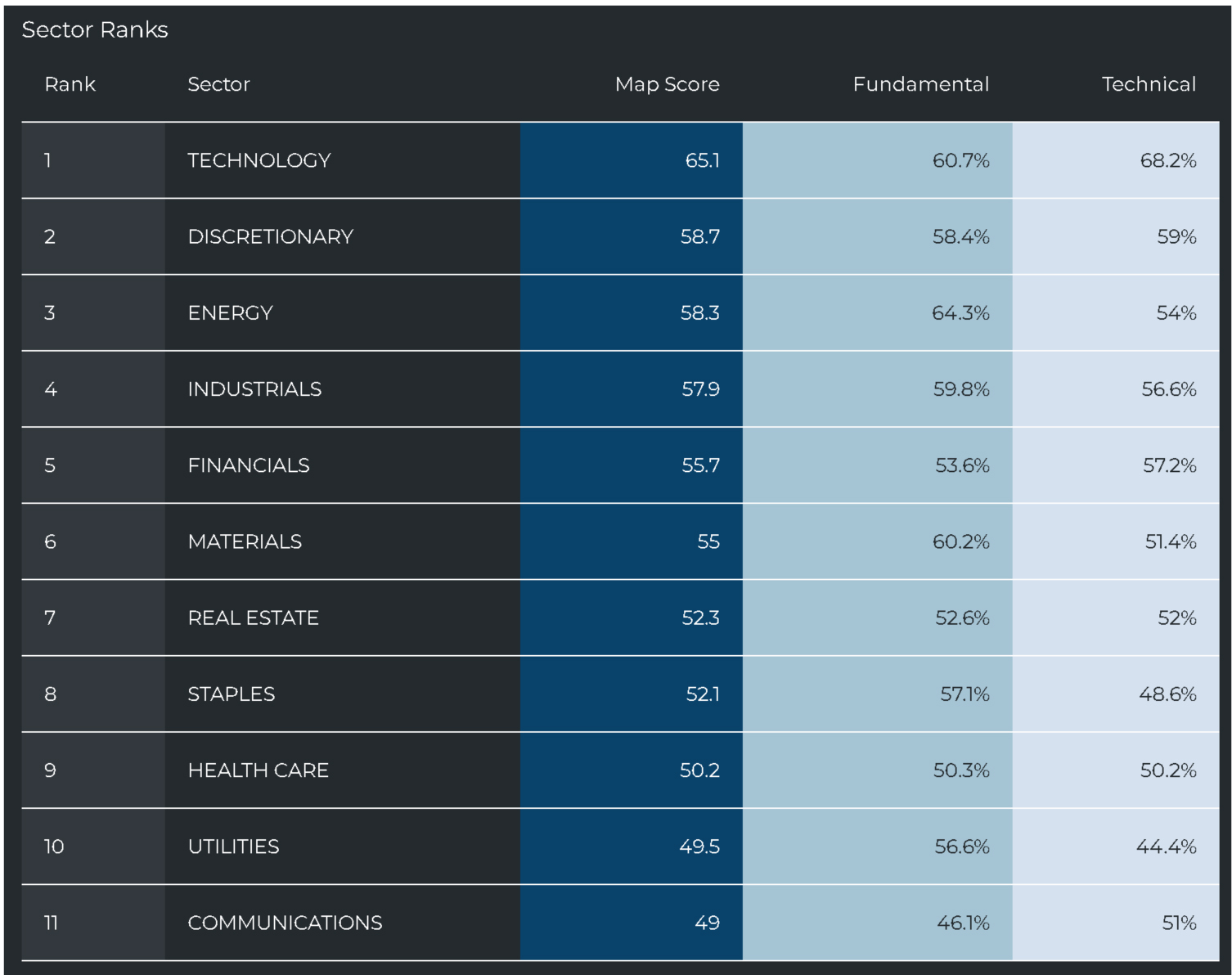
Graphs are for illustrative and discussion purposes only. Please read important disclosures at the end of this commentary.
Defensive sectors like Staples, Utilities, Real Estate, and Communication remain near the bottom of the list. Health Care remains a tale of Jekyll and Hyde. Many are old dividend plays, while the other half are young, growth tech-oriented companies. So there seems to be a persistent push-pull within the sector.
We don’t need to go into great detail on each sector. The main takeaway from the 11 individual sector charts, below, is that money is flowing strongly into all 11 sectors.
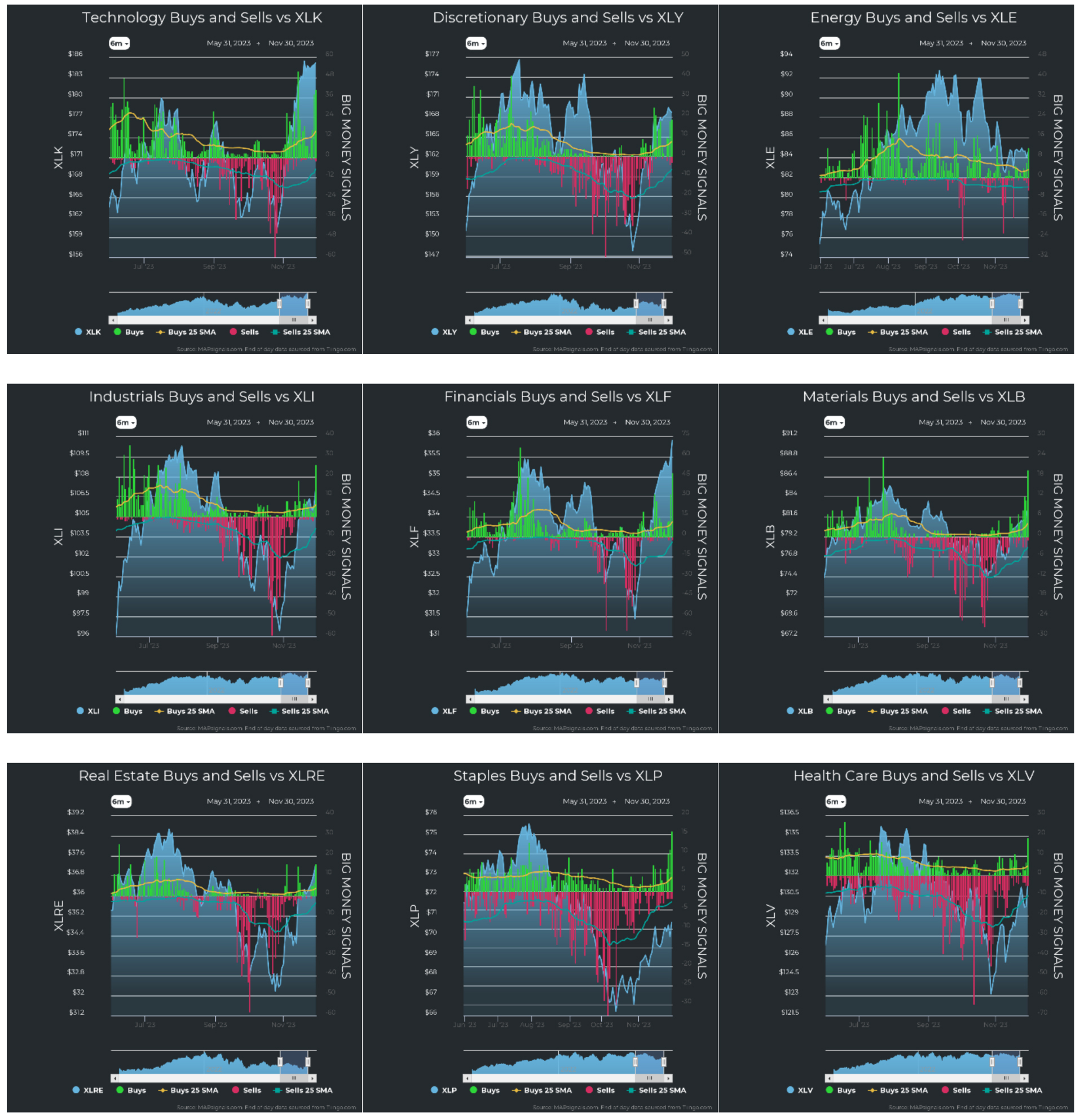
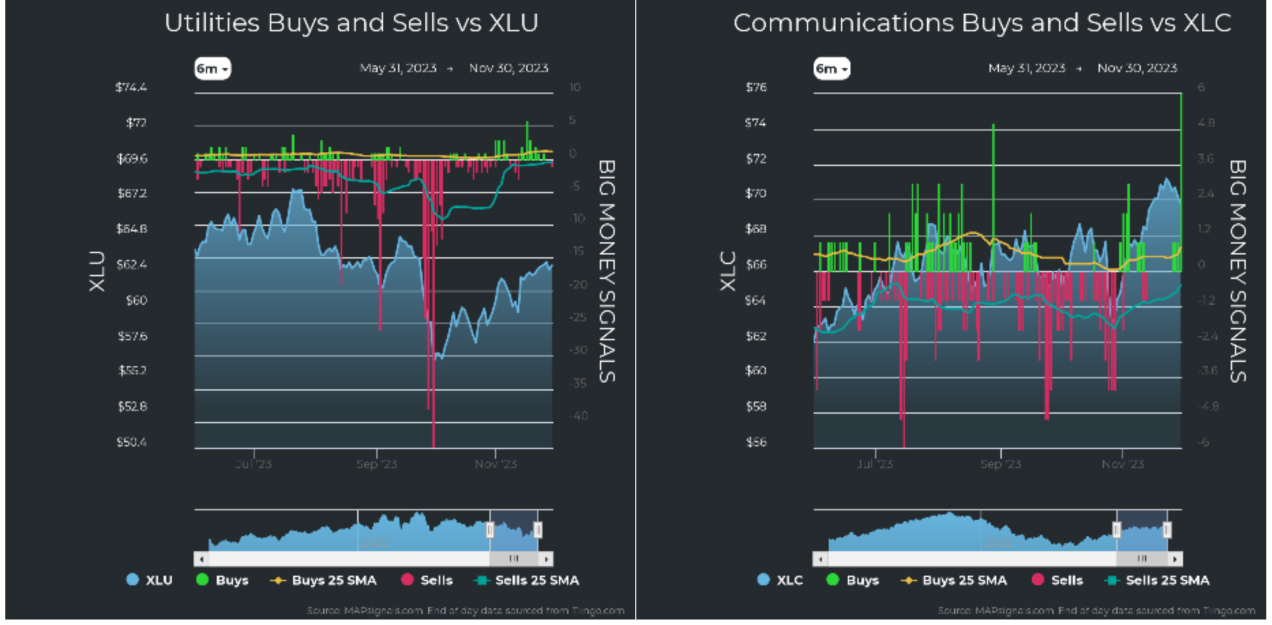
Graphs are for illustrative and discussion purposes only. Please read important disclosures at the end of this commentary.
Perhaps even more telling is that selling has evaporated from all 11 sectors. If this were a rotational rally, we’d see selling in some sectors and big inflows in others, but that’s not what we see here.
Money is moving into stocks. Rates haven’t fallen yet, but when they do, I suspect that we are in for a very big run in stocks, one that will last for a while. The cash bubble is about to burst. When it does, I think tech and discretionary stocks will lead us to new highs.
After the forest fire comes new life. As Oscar Wilde said, “What fire does not destroy, it hardens.”
All content above represents the opinion of Jason Bodner of Navellier & Associates, Inc.
Also In This Issue
A Look Ahead by Louis Navellier
The Fourth Quarter Started Slow, but It May Finish Strong
Income Mail by Bryan Perry
Stocks Building on Gains Under the Power Of Bullish Fund Flows
Growth Mail by Gary Alexander
After a Bountiful Thanksgiving, Will Santa Deliver Too?
Global Mail by Ivan Martchev
A “Reluctant Rotation” Has Begun
Sector Spotlight by Jason Bodner
Only You Can Prevent (or Profit From) Market “Forest Fires”
View Full Archive
Read Past Issues Here

Jason Bodner
MARKETMAIL EDITOR FOR SECTOR SPOTLIGHT
Jason Bodner writes Sector Spotlight in the weekly Marketmail publication and has authored several white papers for the company. He is also Co-Founder of Macro Analytics for Professionals which produces proprietary equity accumulation/distribution research for its clients. Previously, Mr. Bodner served as Director of European Equity Derivatives for Cantor Fitzgerald Europe in London, then moved to the role of Head of Equity Derivatives North America for the same company in New York. He also served as S.V.P. Equity Derivatives for Jefferies, LLC. He received a B.S. in business administration in 1996, with honors, from Skidmore College as a member of the Periclean Honors Society. All content of “Sector Spotlight” represents the opinion of Jason Bodner
Important Disclosures:
Jason Bodner is a co-founder and co-owner of Mapsignals. Mr. Bodner is an independent contractor who is occasionally hired by Navellier & Associates to write an article and or provide opinions for possible use in articles that appear in Navellier & Associates weekly Market Mail. Mr. Bodner is not employed or affiliated with Louis Navellier, Navellier & Associates, Inc., or any other Navellier owned entity. The opinions and statements made here are those of Mr. Bodner and not necessarily those of any other persons or entities. This is not an endorsement, or solicitation or testimonial or investment advice regarding the BMI Index or any statements or recommendations or analysis in the article or the BMI Index or Mapsignals or its products or strategies.
Although information in these reports has been obtained from and is based upon sources that Navellier believes to be reliable, Navellier does not guarantee its accuracy and it may be incomplete or condensed. All opinions and estimates constitute Navellier’s judgment as of the date the report was created and are subject to change without notice. These reports are for informational purposes only and are not a solicitation for the purchase or sale of a security. Any decision to purchase securities mentioned in these reports must take into account existing public information on such securities or any registered prospectus.To the extent permitted by law, neither Navellier & Associates, Inc., nor any of its affiliates, agents, or service providers assumes any liability or responsibility nor owes any duty of care for any consequences of any person acting or refraining to act in reliance on the information contained in this communication or for any decision based on it.
Past performance is no indication of future results. Investment in securities involves significant risk and has the potential for partial or complete loss of funds invested. It should not be assumed that any securities recommendations made by Navellier. in the future will be profitable or equal the performance of securities made in this report. Dividend payments are not guaranteed. The amount of a dividend payment, if any, can vary over time and issuers may reduce dividends paid on securities in the event of a recession or adverse event affecting a specific industry or issuer.
None of the stock information, data, and company information presented herein constitutes a recommendation by Navellier or a solicitation to buy or sell any securities. Any specific securities identified and described do not represent all of the securities purchased, sold, or recommended for advisory clients. The holdings identified do not represent all of the securities purchased, sold, or recommended for advisory clients and the reader should not assume that investments in the securities identified and discussed were or will be profitable.
Information presented is general information that does not take into account your individual circumstances, financial situation, or needs, nor does it present a personalized recommendation to you. Individual stocks presented may not be suitable for every investor. Investment in securities involves significant risk and has the potential for partial or complete loss of funds invested. Investment in fixed income securities has the potential for the investment return and principal value of an investment to fluctuate so that an investor’s holdings, when redeemed, may be worth less than their original cost.
One cannot invest directly in an index. Index is unmanaged and index performance does not reflect deduction of fees, expenses, or taxes. Presentation of Index data does not reflect a belief by Navellier that any stock index constitutes an investment alternative to any Navellier equity strategy or is necessarily comparable to such strategies. Among the most important differences between the Indices and Navellier strategies are that the Navellier equity strategies may (1) incur material management fees, (2) concentrate its investments in relatively few stocks, industries, or sectors, (3) have significantly greater trading activity and related costs, and (4) be significantly more or less volatile than the Indices.
ETF Risk: We may invest in exchange traded funds (“ETFs”) and some of our investment strategies are generally fully invested in ETFs. Like traditional mutual funds, ETFs charge asset-based fees, but they generally do not charge initial sales charges or redemption fees and investors typically pay only customary brokerage fees to buy and sell ETF shares. The fees and costs charged by ETFs held in client accounts will not be deducted from the compensation the client pays Navellier. ETF prices can fluctuate up or down, and a client account could lose money investing in an ETF if the prices of the securities owned by the ETF go down. ETFs are subject to additional risks:
- ETF shares may trade above or below their net asset value;
- An active trading market for an ETF’s shares may not develop or be maintained;
- The value of an ETF may be more volatile than the underlying portfolio of securities the ETF is designed to track;
- The cost of owning shares of the ETF may exceed those a client would incur by directly investing in the underlying securities; and
- Trading of an ETF’s shares may be halted if the listing exchange’s officials deem it appropriate, the shares are delisted from the exchange, or the activation of market-wide “circuit breakers” (which are tied to large decreases in stock prices) halts stock trading generally.
Grader Disclosures: Investment in equity strategies involves substantial risk and has the potential for partial or complete loss of funds invested. The sample portfolio and any accompanying charts are for informational purposes only and are not to be construed as a solicitation to buy or sell any financial instrument and should not be relied upon as the sole factor in an investment making decision. As a matter of normal and important disclosures to you, as a potential investor, please consider the following: The performance presented is not based on any actual securities trading, portfolio, or accounts, and the reported performance of the A, B, C, D, and F portfolios (collectively the “model portfolios”) should be considered mere “paper” or pro forma performance results based on Navellier’s research.
Investors evaluating any of Navellier & Associates, Inc.’s, (or its affiliates’) Investment Products must not use any information presented here, including the performance figures of the model portfolios, in their evaluation of any Navellier Investment Products. Navellier Investment Products include the firm’s mutual funds and managed accounts. The model portfolios, charts, and other information presented do not represent actual funded trades and are not actual funded portfolios. There are material differences between Navellier Investment Products’ portfolios and the model portfolios, research, and performance figures presented here. The model portfolios and the research results (1) may contain stocks or ETFs that are illiquid and difficult to trade; (2) may contain stock or ETF holdings materially different from actual funded Navellier Investment Product portfolios; (3) include the reinvestment of all dividends and other earnings, estimated trading costs, commissions, or management fees; and, (4) may not reflect prices obtained in an actual funded Navellier Investment Product portfolio. For these and other reasons, the reported performances of model portfolios do not reflect the performance results of Navellier’s actually funded and traded Investment Products. In most cases, Navellier’s Investment Products have materially lower performance results than the performances of the model portfolios presented.
This report contains statements that are, or may be considered to be, forward-looking statements. All statements that are not historical facts, including statements about our beliefs or expectations, are “forward-looking statements” within the meaning of The U.S. Private Securities Litigation Reform Act of 1995. These statements may be identified by such forward-looking terminology as “expect,” “estimate,” “plan,” “intend,” “believe,” “anticipate,” “may,” “will,” “should,” “could,” “continue,” “project,” or similar statements or variations of such terms. Our forward-looking statements are based on a series of expectations, assumptions, and projections, are not guarantees of future results or performance, and involve substantial risks and uncertainty as described in Form ADV Part 2A of our filing with the Securities and Exchange Commission (SEC), which is available at www.adviserinfo.sec.gov or by requesting a copy by emailing info@navellier.com. All of our forward-looking statements are as of the date of this report only. We can give no assurance that such expectations or forward-looking statements will prove to be correct. Actual results may differ materially. You are urged to carefully consider all such factors.
FEDERAL TAX ADVICE DISCLAIMER: As required by U.S. Treasury Regulations, you are informed that, to the extent this presentation includes any federal tax advice, the presentation is not written by Navellier to be used, and cannot be used, for the purpose of avoiding federal tax penalties. Navellier does not advise on any income tax requirements or issues. Use of any information presented by Navellier is for general information only and does not represent tax advice either express or implied. You are encouraged to seek professional tax advice for income tax questions and assistance.
IMPORTANT NEWSLETTER DISCLOSURE:The hypothetical performance results for investment newsletters that are authored or edited by Louis Navellier, including Louis Navellier’s Growth Investor, Louis Navellier’s Breakthrough Stocks, Louis Navellier’s Accelerated Profits, and Louis Navellier’s Platinum Club, are not based on any actual securities trading, portfolio, or accounts, and the newsletters’ reported hypothetical performances should be considered mere “paper” or proforma hypothetical performance results and are not actual performance of real world trades. Navellier & Associates, Inc. does not have any relation to or affiliation with the owner of these newsletters. There are material differences between Navellier Investment Products’ portfolios and the InvestorPlace Media, LLC newsletter portfolios authored by Louis Navellier. The InvestorPlace Media, LLC newsletters contain hypothetical performance that do not include transaction costs, advisory fees, or other fees a client might incur if actual investments and trades were being made by an investor. As a result, newsletter performance should not be used to evaluate Navellier Investment services which are separate and different from the newsletters. The owner of the newsletters is InvestorPlace Media, LLC and any questions concerning the newsletters, including any newsletter advertising or hypothetical Newsletter performance claims, (which are calculated solely by Investor Place Media and not Navellier) should be referred to InvestorPlace Media, LLC at (800) 718-8289.
Please note that Navellier & Associates and the Navellier Private Client Group are managed completely independent of the newsletters owned and published by InvestorPlace Media, LLC and written and edited by Louis Navellier, and investment performance of the newsletters should in no way be considered indicative of potential future investment performance for any Navellier & Associates separately managed account portfolio. Potential investors should consult with their financial advisor before investing in any Navellier Investment Product.
Navellier claims compliance with Global Investment Performance Standards (GIPS). To receive a complete list and descriptions of Navellier’s composites and/or a presentation that adheres to the GIPS standards, please contact Navellier or click here. It should not be assumed that any securities recommendations made by Navellier & Associates, Inc. in the future will be profitable or equal the performance of securities made in this report.
FactSet Disclosure: Navellier does not independently calculate the statistical information included in the attached report. The calculation and the information are provided by FactSet, a company not related to Navellier. Although information contained in the report has been obtained from FactSet and is based on sources Navellier believes to be reliable, Navellier does not guarantee its accuracy, and it may be incomplete or condensed. The report and the related FactSet sourced information are provided on an “as is” basis. The user assumes the entire risk of any use made of this information. Investors should consider the report as only a single factor in making their investment decision. The report is for informational purposes only and is not intended as an offer or solicitation for the purchase or sale of a security. FactSet sourced information is the exclusive property of FactSet. Without prior written permission of FactSet, this information may not be reproduced, disseminated or used to create any financial products. All indices are unmanaged and performance of the indices include reinvestment of dividends and interest income, unless otherwise noted, are not illustrative of any particular investment and an investment cannot be made in any index. Past performance is no guarantee of future results.
